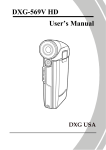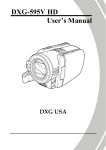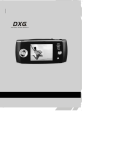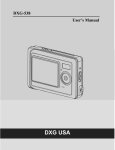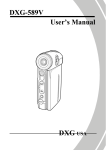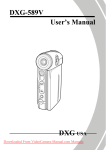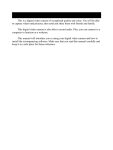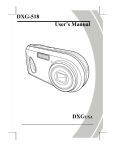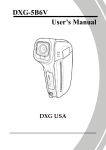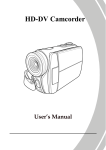Download DXG DXG-110 User`s manual
Transcript
DXG-110 User’s Manual DXG USA Preface Congratulations on your purchase of this advanced digital camera. Be sure to read this manual carefully and keep it in a safe place for future reference. About this manual Every effort has been made to ensure that the contents of this manual are correct and up to date. However, no guarantee is made regarding the accuracy of the contents. If the contents of this manual do not tally with the camera, please take the camera as a criterion. We reserve the right to change the contents of this manual and specifications of the product without prior notice. If the accessories do not tally with the actual package, please take the actual package as a criterion. Copyright © Copyright 2007. All rights reserved. No part of this publication may be reproduced, transmitted, transcribed, stored in a retrieval system or translated into any language or computer language, in any form or by any means, electronic, mechanical, magnetic, optical, manual or otherwise, without the prior written permission of the manufacturer. I Precautions General precautions o o o o o o o o o II Do not use or store the product in dusty, dirty, or sandy areas, as its components may be damaged. Do not store the product in a hot environment. High temperatures can shorten the life of electronic devices, damage batteries and warp or melt certain plastics. Do not store the product in cold areas. When the product warms up to its normal temperature, moisture can form inside; this may damage the electronic circuits. Do not attempt to open the casing or attempt your own repairs. High-voltage internal components create the risk of electric shock when exposed. Do not drop or knock the product. Rough handling may damage the internal components. Do not use harsh chemicals, cleaning solvents or strong detergents to clean the product. Wipe the product with a slightly damp soft cloth. Do not fire the flash while it is too close to the subject's eyes. Intense light from the flash can cause eye damage if it is fired too close to the eyes. When using the flash, the camera should be at least one meter from the eyes of the subject. Do not open battery cover while an image is being recorded. Doing so will not only make storage of the current image impossible, it can also corrupt other image data already stored in file. If the product or any of its accessories are not working properly, take them to your nearest qualified service o o center. The personnel there will assist you and if necessary, arrange for the product to be repaired. Test for proper operation before using the camera. Before using the camera to record images, make sure you first record a number of test images and check the results to ensure that the camera is configured correctly and operating properly Operation conditions This camera is designed for use in temperatures ranging for 0°C to 40°C (32°F to 104°F) Do not use or keep the camera in the following areas: - in areas subject to direct sunlight - in areas subject to high humidity or dust - near air conditioners, heaters, or other areas subject to temperature extremes - inside of a closed vehicle, especially one parked in the sun - in areas subject to strong vibration III Table of contents Preface .................................................................... I About this manual...................................................... I Copyright .................................................................... I Precautions............................................................... II 1. Introducing the camera................................. 6 1.1. 1.2. 1.3. 1.4. 1.4.1. 1.4.2. 1.4.3. 1.4.4. 2. Front view ..............................................................8 Top view.................................................................9 Back view................................................................9 Right view ............................................................10 Getting started ............................................. 11 2.1. 2.2. 2.3. 2.4. 2.5. 2.5.1. 2.5.2. 2 System requirements .....................................6 Features.........................................................6 Unpacking .....................................................7 About the camera ..........................................8 Inserting an SD card...................................11 Inserting the batteries .................................12 Turning on for the first time .......................13 Changing modes..........................................13 Before you start ...........................................14 Setting the date and time....................................14 Setting the language............................................15 2.6. 2.6.1. 2.6.2. 2.7. 2.7.1. 2.7.2. 2.8. 2.8.1. 2.8.2. 2.9. 2.10. 2.11. 3. Taking/viewing pictures ..............................16 Taking a still picture ...........................................16 Viewing pictures..................................................16 Shooting/ Playing videos.............................17 Shooting a video clip...........................................17 Playing back video clips .....................................17 Voice recording............................................18 Taking a voice recording ....................................18 Playing back voice files.......................................18 Using the Playback Button .........................19 Connecting to a computer...........................19 Connecting to a TV .....................................20 Using the camera .........................................21 3.1. 3.1.1 3.1.2 3.2. 3.2.1. 3.2.2. 3.2.3. 3.2.4. 3.2.5. 3.2.6. 3.2.7. 3.3. 3.3.1. Using the camera buttons ...........................21 Back View.............................................................21 Top View ..............................................................21 Photo mode..................................................24 Photo mode icons ................................................24 Scene selection .....................................................26 Capture mode and self-timer function .............27 Setting the flash ...................................................27 Using the macro function ...................................28 Using the zoom function ....................................28 Using the custom WB function..........................29 Video mode ..................................................30 Video mode icons ................................................30 3 3.4. REC mode....................................................31 3.4.1. 3.5. REC mode icons...................................................31 Playback mode ............................................32 3.5.1. 3.5.2. 3.5.3. 3.6. Displaying file information................................32 Playback mode icons...........................................33 Thumbnail mode .................................................34 USB mode....................................................35 3.6.1. 4. Storage device mode ...........................................35 Using the menus...........................................36 4.1. Picture menu ...............................................36 4.1.1. 4.1.2. 4.1.3. 4.1.4. 4.1.5. 4.1.6. 4.1.7. 4.1.8. 4.1.9. 4.1.10. 4.2. 4.2.1. 4.2.2. 4.3. 4.3.1. 4.3.2. 4 Scene .....................................................................36 Size ........................................................................37 Date stamp ...........................................................37 Quality ..................................................................38 Color......................................................................38 White balance.......................................................39 Focus selection .....................................................40 Metering ...............................................................41 Exposure adjustment (EV) .................................42 ISO.........................................................................43 Video menu..................................................44 Video Size.............................................................44 Video Quality.......................................................45 Playback menu ............................................46 Delete all ...............................................................46 Protect ...................................................................47 4.3.3. 4.3.4. 4.3.5. 4.3.6. 4.4. Slide show ............................................................48 DYNA. fill light....................................................49 DPOF.....................................................................50 Copy to card.........................................................51 Setup menu..................................................52 4.4.1. 4.4.2. 4.4.3. 4.4.4. 4.4.5. 4.4.6. 4.4.7. 4.4.8. 4.4.9. 4.4.10. 5. Date/time .............................................................52 Set date type.........................................................52 Number reset .......................................................52 Beep.......................................................................53 Language ..............................................................54 Power saving........................................................54 Default ..................................................................54 Format...................................................................55 USB Mode.............................................................56 TV ..........................................................................57 Installing the software.................................58 5.1. 5.2. NewSoft VideoWorks...................................58 NewSoft Mr. Photo......................................59 Appendix .............................................................. 60 Specifications ...........................................................60 Troubleshooting .......................................................62 5 1. Introducing the camera Read this section to learn about the features and functions of the camera. This chapter also covers system requirements, package contents, and descriptions of the hardware components. 1.1. System requirements The camera requires a host PC with the following specifications: Windows® Vista, XP, 2000, ME operating system Intel® Pentium III 500 MHz CPU or higher At least 256 MB of RAM or higher Standard USB 1.1 port or higher 4x speed CD-ROM drive or higher At least 200 MB of available disk space Note: A USB 1.1 port will enable you to transfer files to and from your host PC, but transfer speeds will be much faster with a USB 2.0 port. 1.2. Features The camera is packed full of features and functions including: Digital still camera (10 Megapixels) Digital camcorder Mass storage device Voice recorder 3X optical zoom and 4X digital zoom Card reader Face detection AF tracking Direct print function 6 1.3. Unpacking The following items should be present in the camera package. If any item is missing or appears damaged, contact your dealer immediately. Digital camera Wrist strap Pouch AA batteries x 2 CD-ROM (Driver and application software) USB/AV cable User manual 7 1.4. About the camera Refer to the following illustrations to familiarize yourself with the buttons and controls of the camera. 1.4.1. Front view Flash AF lamp Lens Microphone 8 1.4.2. Top view Power button Speaker Shutter button 1.4.3. Back view Power LED Busy LED (Red) (Green) Zoom out/ Zoom in button Mode button Joystick Playback button Delete button LCD screen Menu button 9 1.4.4. Right view USB/AV port 1.4.4. Bottom view Tripod Mount 10 2. Getting started Read this section to learn how to start using the camera. This section covers only basic functions such as inserting the battery and memory cards, turning it on, and making preliminary settings. See later chapters for advanced functions. 2.1. Inserting an SD card An SD card can be installed in the camera to provide additional storage space for still images, video clips, or other files. 1. Open the battery cover. 2. Insert the SD card as shown. Make sure the gold contacts are facing down as shown. 3. Close the battery cover. 11 2.2. Inserting the batteries The camera is powered by two alkaline AA batteries. Note: Install the batteries exactly as described here. Ensure that the polarity of the batteries is correct. Installing the batteries incorrectly could cause damage to the camera and possibly start a fire. 1. Open the battery cover. 2. Insert the batteries as shown 3. Close the battery cover. 12 2.3. Turning on for the first time Press and hold the power button about two seconds to turn on/off the camera. Power button 2.4. Changing modes The camera can operate in four modes, Auto mode, Program mode, to Video mode, and Record mode. Press the Mode button switch between modes. Mode button 13 2.5. Before you start Before using the camera, some basic settings need to be configured and are described in the following sections. 2.5.1. Setting the date and time 1. Turn on the camera, and press the MENU button to display the menu screen. 2. Move the joystick right to show the setup menu and move it down to highlight the Date/Time option. 3. Use the joystick to highlight each field, and adjust the value. After the changes are done, and press the center joystick to confirm. 4. Press the MENU button again to exit the menu. 14 2.5.2. Setting the language 1. Turn the camera on, and press the MENU button to display the menu screen. 2. Move the joystick right to show the setup menu and move it down to highlight the language option. 3. Use the joystick to change between languages. 4. Press the MENU button again to exit the menu. 15 2.6. Taking/viewing pictures 2.6.1. Taking a still picture 1. Turn on the camera and make sure it is in Photo mode, indicated by the camera icon on the top left corner of the screen. 2. Use the LCD screen to frame the picture. 3. Press the shutter button to capture the picture. The picture will automatically be saved with a unique file name. 2.6.2. Viewing pictures 1. Press the Playback button, the most recent file will be shown on the LCD screen. If you are using the Playback button to turn on the camera, press and hold for at least one second. 2. To display the previous image, move the joystick left. 3. To display the next image, move the joystick right. 4. Use the Zoom out/Zoom in buttons to enlarge/reduce the image. 5. Press the Mode button to return to Photo mode, or press the Power button to turn off the camera once you have finished viewing images. 16 2.7. Shooting/ Playing videos 2.7.1. Shooting a video clip 1. Turn on the camera and make sure it is in Video mode, indicated by a video camera icon on the top left corner of the screen. 2. Use the LCD screen to frame the video. 3. Press the shutter button to start recording. 4. Press the shutter button again to stop. The video clip will automatically be saved with a unique file name. 2.7.2. Playing back video clips 1. Press the Playback button, the most recent file will be shown on the LCD screen. If you are using the Playback button to turn on the camera, press and hold for at least one second. 2. To display the previous video clip, move the joystick left. 3. To display the next video clip, move the joystick right. 4. Press the joystick to playback the video clip. 5. When reviewing the video clip, use the joystick up/down to adjust the volume. 6. Press the joystick again to stop. 7. Press the Mode button to return to Video mode, or press the Power button to turn off the camera once you have finished playing back video clips. 17 2.8. Voice recording 2.8.1. Taking a voice recording 1. Turn on the camera and make sure it is in REC mode. 2. Press the shutter button to start recording. 3. Press the shutter button again to stop. The voice file will automatically be saved with a unique file name. 2.8.2. Playing back voice files 1. Press the Playback button, the most recent file will be shown on the LCD screen. If you are using the Playback button to turn on the camera, press and hold for at least one second. 2. To display the previous voice file, move the joystick left. 3. To display the next voice file, move the joystick right. 4. Press the joystick to playback the voice file. 5. When reviewing a voice file, use the joystick up/down to adjust the volume. 6. Press the joystick again to stop. 7. Press the Mode button to return to REC mode, or press the Power button to turn off the camera once you have finished playing back voice files. 18 2.9. Using the Playback Button You can also use the Playback go directly into Playback mode. button to turn on the camera and 1. Press and hold the Playback button for at least one second. The last image, video clip, or voice clip is displayed. 2. To display the previous image, video clip, or voice clip, move the joystick left. 3. To display the next image, video clip, or voice clip, move the joystick right. 4. Once you have finished viewing your images, playing back video clips, and voice clips, press the Power button to turn off the camera. 2.10. Connecting to a computer Read this section to learn how to transfer files to a PC. Connect the camera to a computer with the USB cable provided. 19 2.11. Connecting to a TV Connect the camera to a TV as shown with the AV cable provided. 20 3. Using the camera Read this section to learn how to use the camera. 3.1. Using the camera buttons All buttons are located on the top and the back of the camera. 3.1.1 Back View Power LED Busy LED (Red) Zoom out/ Zoom in button (Green) Mode button Joystick Playback button Delete button LCD screen 3.1.2 Menu button Top View Speaker Power button Shutter button Zoom out/ Zoom in button 21 See the table below for a description of each button’s function. Button Function Name Zoom out Zoom in Press to switch between Photo mode (auto), Photo mode (program), Video mode, and REC mode. Press to playback images, video clips, or recorded voice files. When the camera is off, press and hold for at least one second to turn on the camera and enter Playback mode. Mode Playback Joystick 22 Press to zoom out/in while taking pictures or shooting video clips. Press to enlarge/ reduce images while reviewing still images. While in Playback mode, press the Zoom out button to view thumbnails of all files stored in memory. Use to navigate OSD menus. In Photo mode, move right to use self-timer/continuous shooting function, move left to change flash mode, move up to adjust the EV value, and move down to use macro function or face detection function. In Video mode, move down to use macro function Delete Menu Enter Press to display main OSD menu. In Photo mode or Video mode, press to display OSD. In Playback mode, press to display image information or play/ stop a video. Shutter Power In Photo mode (program), press to turn custom WB function on/ off. Press to display the delete option when in Playback mode. Press to capture a picture in Photo mode. Press to start/stop the video/voice recording in Video/ REC mode. Press to turn power on/off. 23 3.2. Photo mode Use Photo mode to capture still pictures and store them in internal memory or on an SD card. There are two Photo modes: Auto mode and Program mode . 3.2.1. Photo mode icons Use the following picture to familiarize yourself with the photo mode icons and symbols. 10 11 12 13 14 9 8 1 7 6 5 4 2 3 See the table below for a description of each icon and symbol. 24 1 Displays the number of available shots while using current settings. 2 Optical/Digital zoom ratio status 3 Focus zone. The camera focuses on this area inside this frame. 4 Battery status indication Storage directory indicator 5 : Internal memory space : SD card memory space Macro function indicator 6 This function is on when showing the icon. The icon will not be shown when this function is off. 7 Flash mode indicator Capture mode indicator 8 : Single shot : Continuous shot : Self-timer function (10 seconds) Photo mode icon 9 : Auto : Program (manual) 10 Scene choice: Select scene setting according to different capturing situations. This selection is enabled only in program mode. 11 Resolution. The higher the resolution is, the bigger photo size will be. 12 Color. : This icon will be in color if the camera is set to take color pictures. Black/White: Taking black/white pictures. Sepia tones: Taking sepia pictures. 13 ISO indicator which indicates ISO setting: Auto, 100, 200, 400, 800, and 1600. 14 White balance 25 3.2.2. Scene selection Icon Name Description Manual See Section 4.1.1 “Scene”. Portrait For capturing close subjects in good light conditions. Landscape For capturing distant subjects in good light conditions. For capturing moving objects. In this Sports/Action 26 mode, press to turn on/ off the AF tracking option. An icon when AF tracking is on. is shown Night portrait For capturing close subjects in dark environments. Night landscape For capturing distant subjects in low light conditions. Sunset For capturing sunsets or when shooting towards the light Backlight For capturing images with strong backlight. Fireworks For capturing pictures of bright subjects in dark environments. Ideal for fireworks. Beach For capturing images in bright sunlight with large reflective surfaces. Party For capturing action in low light conditions with partly on-site bright light. Text For capturing close subjects of high details in good light conditions. 3.2.3. Capture mode and self-timer function Single shot: Only one picture will be taken. Continuous shot: Three pictures will be taken in short succession when the shutter button is pressed. Self-timer: This function lets you capture an image of yourself by adding a time delay between when the shutter button is pressed and when the picture is taken. Note: Continuous shot is not available when the camera is set to 12M (12 megapixels). 3.2.4. Setting the flash While in Photo mode, move the joystick left to switch between flash modes. See the table below for a description of each icon and symbol. Flash is turned off. Flash fires automatically when needed and flashes once before the picture is taken to reduce the red-eye effect. Forced flash, flash is always on. Slow sync flash. A flash mode designed for low light conditions with long shutter speed. 27 3.2.5. Using the macro function This function can capture subjects very close to the lens. In macro mode, subjects can be as close as 5 cm. While in photo mode, move the joystick downward to activate macro function, and an icon will appear on the LCD screen. Move the joystick downwards again to cancel the macro function. 3.2.6. Using the zoom function The camera is equipped with 3x optical zoom and 4x digital zoom. The zoom function will work in Photo mode and Video mode (before recording begins). Press the Zoom in button to get closer to a subject. Press the Zoom out button to move away from a subject. The ratio status bar on the right of the screen indicates the zoom status. Zoom Status 28 3.2.7. Using the custom WB function Use this function to define your own white balance reference. In Photo mode, focus an area that should be white or neutral gray, then press to turn custom WB function on. The camera will use the WB reference for taking a picture. 29 3.3. Video mode Use Video mode to capture video clips and store them in internal memory or on an SD card. 3.3.1. Video mode icons Use the following picture to familiarize with the Video mode icons and symbols. 7 6 1 5 4 2 3 See the table below for a description of each icon and symbol. 1 Zoom ratio status bar 2 Timer 3 Record/stop icons 4 Battery status indicator 5 Storage directory indicator. : Internal memory space : SD card memory space 30 6 Video mode icon 7 Focus zone. The camera focuses on this area inside this frame. 3.4. REC mode Use REC mode to record a voice file and store them in internal memory or on an SD card. 3.4.1. REC mode icons Use the following picture to familiarize yourself with the REC mode icons and symbols. 5 4 3 1 2 See the table below for a description of each icon and symbol. 1 Timer 2 REC start/stop icon 3 Battery status indication Storage directory indicator. 4 : Internal memory space : SD card memory space 5 REC mode icon 31 3.5. Playback mode Use Playback mode to review all the files stored in the camera. You can also turn on the camera using the Playback button. Press and hold the Playback button for at least one second, and the most recently captured image is displayed. When you have finished viewing images, press the Power button to turn off the camera. 3.5.1. Displaying file information Basic information is displayed by default on each image when viewed in Playback mode. Press the Joystick button to switch this information on or off. 1. Turn on the camera and make sure it is in Playback mode. 2. The most recent file will be shown on the LCD screen with basic information such as file type, storage directory, battery, etc. 3. Press the Joystick button for the first time to show detailed file information when captured. 4. Press the Joystick button for the second time to remove all the information on the screen and show only the picture. 5. Press the Joystick button for the third time to restore basic information. Note: Video files only show basic information. 32 3.5.2. Playback mode icons Refer to the following picture to familiarize yourself with the Playback mode icons and symbols. 8 1 7 6 5 4 2 3 See the table below for a description of each icon and symbol. 1 Displays the number of current shot and total number of pictures/video clips/voice files. 2 Counter shows the total time of current video. Shows only for a video clip/voice file. 3 Play/stop icon. Shows only for a video clip/voice file. 4 Battery status indication Storage directory indicator. 5 6 7 8 : Internal memory space : SD card memory space Lock indicator Shows current file type. : Video clips : Still images : Voice files. Playback mode icon 33 3.5.3. Thumbnail mode When in Playback mode, press the Zoom out button to show image thumbnails. 1. Turn on the camera and make sure it is in Playback mode. 2. The most recent image will show on the screen. Press the Zoom out button for the first time to view four thumbnails on LCD screen, and press the button for the second time to view nine thumbnails on the LCD screen. 3. Move the joystick to highlight an image, press the joystick to view the image full screen size. 4. Press the Zoom out button again to return thumbnail mode. Note: Voice files fill only show the icon in thumbnail mode. 34 3.6. USB mode Before connecting to a PC, refer to Section 5 “Installing the software”. The camera can be set as a USB mass storage device when connected to a PC via the USB cable. 3.6.1. Storage device mode When used as a USB mass storage device, the camera displays as a removable drive in Windows Explorer. The removable drive directly accesses the SD card only. If the SD card is not present, the camera internal memory is made available. Drag and drop files to and from the device like any other drive. 35 4. Using the menus Read this section to learn how to configure the camera and use the advanced features. 4.1. Picture menu There are two photo modes: auto mode and program mode. Only the following options are available in auto mode: size, quality, color and date stamp. In Photo mode, press the MENU button to show the menu. 4.1.1. Scene The scene option can be set to manual , where WB (white balance), focus selection, metering, EV, and ISO can be set manually. There are also other preset scene options and all these variables are preset. When a preset scene option is chosen, focus, white balance, EV, ISO, and metering cannot be altered. 1. Turn the camera on and ensure it is in Photo mode. 2. Press the MENU button and move the joystick down to highlight the Scene option. 3. Use the joystick to select a scene setting. 4. Press the MENU button again to exit the menu. Note: The Scene option is enabled only when photo mode is set to program (manual). 36 4.1.2. Size Use this option to set the size of the captured image. Bigger images contain more detail and therefore use more memory space. 1. Turn the camera on and ensure it is in Photo mode. 2. Press the MENU button and move the joystick down to highlight the Size option. 3. Use the joystick to select 12M, 10M, 5M, 2M or VGA. 4. Press the MENU button again to exit the menu. 4.1.3. Date stamp Use this option to turn on/off the date stamp when the photo is captured. 1. Turn the camera on and ensure it is in Photo mode. 2. Press the MENU button and move the joystick down to highlight the Date stamp option. Press the joystick to confirm. 3. Use the joystick to select whether the date stamp shows on the captured image. 4. Press the MENU button again to exit the menu. 37 4.1.4. Quality Use this option to set the quality of the captured image. Better quality contains more details and therefore uses more memory space. 1. Turn the camera on and ensure it is in Photo mode. 2. Press the MENU button and move the joystick down to highlight the Quality option. 3. Use the joystick to select from Fine, Normal, or Basic. 4. Press the MENU button again to exit the menu. 4.1.5. Color The camera can capture standard color images, black and white images, or sepia tone to give an old-fashioned look. 1. Turn the camera on and ensure it is in Photo mode. 2. Press the MENU button and move the joystick down to highlight the Color option. 3. Use the joystick to select Color, Black and White, or Sepia. 4. Press the MENU button again to exit the menu. 38 4.1.6. White balance Use this option to correct color difference due to lighting conditions. 1. Turn the camera on and ensure it is in Photo mode. 2. Press the MENU button and move the joystick down to the second page to highlight the WB option. 3. Use the joystick to select Auto, Sunny, Cloudy, Tungsten, or Fluorescent. 4. Press the MENU button again to exit the menu. Note: You can define your white balance reference by using the custom WB function. See Section 3.2.7 “Using the custom WB function” for detailed information. Only available in Program Mode. 39 4.1.7. Focus selection Use this option to determine where the camera focuses. 1. Turn the camera on and ensure it is in Photo mode. 2. Press the MENU button and move the joystick down to the second page to highlight the Focus Selection option. 3. Use the joystick to select Center Top or Bottom . 4. Press the MENU button again to exit the menu. , Left , Right , Note: The Focus Selection option is enabled only when photo mode is set to program (manual). 40 4.1.8. Metering Use this option to determine how the camera light metering is used to calculate the exposure of the picture. 1. Turn the camera on and ensure it is in Photo mode. 2. Press the MENU button and move the joystick down to the second page to highlight the Metering option. 3. Use the joystick to select Matrix Spot metering 4. , Center Weighted , or . Press the MENU button again to exit the menu. Note: The Metering option is enabled only when photo mode is set to program (manual). 41 4.1.9. Exposure adjustment (EV) Use this setting to change the exposure for the pictures. Usually, this value would be set to zero. Increase the value to light up a subject with strong back lighting, or decrease the value if taking a picture of something very bright. 1. Turn the camera on and ensure it is in Photo mode. 2. Press the MENU button and move the joystick down to the second page to highlight the EV option. 3. Use the joystick to adjust EV value. The range is from –2.0 to +2.0. 4. Press the MENU button again to exit the menu. Note: In Photo mode (auto), you can move the joystick up to adjust the EV value. 42 4.1.10. ISO This option is equivalent to the film speed setting on film cameras. In brighter conditions, a low ISO film is needed, correspondingly, in darker conditions, a high ISO film is needed. 1. Turn the camera on and ensure it is in Photo mode. 2. Press the MENU button and move the joystick down to the second page to highlight the ISO option. 3. Use the joystick to select Auto, 100, 200, 400, 800, or 1600. 4. Press the MENU button again to exit the menu. Note: The ISO option is enabled only when photo mode is set to program (manual). 43 4.2. Video menu When in Video mode, press the MENU button to show video menu. 4.2.1. Video Size Use this option to select the video size setting. Larger video size contains more details and therefore uses more memory space. 1. Turn the camera on and ensure it is in Video mode. 2. Press the MENU button and move the joystick downward to highlight the Size option. 3. Use the joystick to select VGA (640 x 480), or QVGA (320 x 240). 44 4.2.2. Video Quality There are three different levels for video quality setting. Higher quality video needs more memory storage space. 1. Turn the camera on and ensure it is in Video mode. 2. Press the MENU button and move the joystick downward to highlight the Quality option. 3. Use the joystick to select Fine, Normal, or Basic. 4. Press the MENU button again to exit the menu. 45 4.3. Playback menu Use the playback menu to manage the files stored in the internal memory or on SD card. 4.3.1. Delete all Use this function to delete files. 1. Turn the camera on and ensure it is in Playback mode. 2. Press the MENU button and move the joystick downward to highlight the Delete all option. 3. Press the joystick to confirm and select No or Yes. Press the joystick to confirm. 4. Press the MENU button again to exit the menu. Note: Once deleted, files cannot be recovered. Make sure the files are transferred to PC via USB cable or saved to other storage device. Files that have been protected will not be deleted. See Section 4.3.2 “Protect” for detailed information. 46 4.3.2. Protect Use this function to protect files from accidental deletion. 1. Turn the camera on and ensure it is in Playback mode. 2. Press the MENU button and move the joystick down to highlight the Protect option. 3. Use the joystick to select Protect One Protect All confirm. 4. , or Unprotect All , Unprotect One , . Press the joystick to Press the MENU button again to exit the menu. Note: Files that have been protected cannot be deleted. To delete a protected file, you must unprotect it first. 47 4.3.3. Slide show The camera includes a slide show function, which displays each image in turn with a regular interval between pictures. 1. Turn the camera on and ensure that it is in Playback mode. 2. The most recent picture is displayed on the screen. 3. Press the MENU button, and move the joystick down to highlight the slide show option. 4. Use the joystick to select 1 second, 3 seconds, 5 seconds, or 10 seconds interval. 5. Press the joystick to confirm and start the slide show. The images stored in memory will be displayed one after another. 6. Press the joystick to pause the slide show. 7. Press the MENU button to stop the slide show. 48 4.3.4. DYNA. fill light Use the DYNA. fill light function to adjust the image quality by brightening up an underexposed captured image, or enhance the contrast of an overexposed captured image. 1. Turn the camera on and ensure that it is in Playback mode. 2. Press the MENU button, and move the joystick down to highlight the DYNA. fill light option. 3. Press the joystick to confirm and select No or Yes. Press the joystick to confirm. When Yes is selected, the adjusted image is saved as a new file. Note: This option is not supported for images of 12M. 49 4.3.5. DPOF Use the DPOF (Digital Print Order Format) function to tag pictures stored in the memory card with print information. Tag all pictures to be printed or just the current picture. 1. Turn the camera on and ensure that it is in Playback mode. 2. Press the MENU button, and move the joystick down to highlight the DPOF option. 3. Use the joystick to select from one or all, and press the joystick to confirm. 4. Use the joystick to select whether the date/time information shows on the printed page, and press it to confirm. 5. Use the joystick to set the number of copies, and press it to confirm. 6. Press the MENU button again to exit the menu. 50 4.3.6. Copy to card Use this function to copy the files saved in internal memory to an SD card. 1. Turn the camera on and ensure it is in Playback mode. 2. Press the MENU button and move the joystick downward to highlight the Copy to card option. 3. Press the joystick to confirm, and start the processing. 4. After the process is complete, it will return to the playback menu automatically. Note: The Copy to card function will not erase the original files; it only makes copies for all files onto an SD card. 51 4.4. Setup menu The setup menu can be accessed from any camera mode and is used to configure the miscellaneous camera functions. 4.4.1. Date/time See Section 2.5.1 “Setting the date and time”. 4.4.2. Set date type 1. Turn the camera on, and press the MENU button to display the menu screen. 2. Move the joystick right to show the setup menu and move it down to highlight the Date type option. 3. Use the joystick to select the desired date type, and press it to confirm. 4. Press the MENU button again to exit the menu. 4.4.3. Number reset Use this function to reset the file name numbers to zero. 1. Turn the camera on, and press the MENU button to display the menu screen. 2. Move the joystick right to show the setup menu and move it down to highlight the Number reset option. 3. Press the joystick to confirm. When camera captures new images or videos, the file name number counter will start over. 52 4. Press the MENU button again to exit the menu. 4.4.4. Beep 1. Turn the camera on, and press the MENU button to display the menu screen. 2. Move the joystick right to show the setup menu and move it down to highlight the Beep option. 3. Use the joystick to select the desired setting, and press it to confirm. : Turns all sounds off. : Sounds appear only when turn on/off the camera. : Sounds appear only when a button is pressed. : Turns all sounds on. 4. Press the MENU button again to exit the menu. 53 4.4.5. Language Please refer to the 2.5.2 “Setting the language” section. 4.4.6. Power saving Use this function to switch the camera off automatically after a period of inactivity for saving power. 1. Turn the camera on, and press the MENU button to display the menu screen. 2. Move the joystick right to show the setup menu and move it down to the second page and highlight the Power saving option. 3. Use the joystick to select 3 minutes, 5 minutes, 10 minutes or Off. 4. Press the MENU again to exit the menu. 4.4.7. Default Use this option to reset all settings to the default factory settings. 1. Turn the camera on, and press the MENU button to display the menu screen. 2. Move the joystick right to show the setup menu and move it down to the second page to highlight the Default option, and press it to confirm. 3. Use the joystick select No or Yes, and press it to confirm. 54 4. Press the MENU button again to exit the menu. 4.4.8. Format Use this function to format the current storage media. This format action will delete everything on the media. 1. Turn the camera on, and press the MENU button to display the menu screen. 2. Move the joystick right to show the setup menu and move it down to the second page to highlight the Format option, and press it to confirm. 3. 4. 5. Use the joystick select No or Yes, and press it to confirm. Select No, it will return to the present operation mode. Press the MENU button again to exit the menu. Select Yes, the formatting starts and returns to the present operation mode after the process is complete. Note: When you format memory, all data is erased. Make sure your files are saved on a PC before formatting. 55 4.4.9. USB Mode Use USB mode to connect the camera to a PC or printer with USB cable. 1. Turn the camera on, and press the MENU button to display the menu screen. 2. Move the joystick right to show the setup menu and move it down to the second page to highlight the USB Mode option. 3. Use the joystick to select a PC or a Printer, and press it to confirm. 4. Press the MENU button to exit the menu. Using DPS feature To use this function, connect the camera to a printer with the USB cable provided. 1. Use the joystick to select a Printer, and press it to confirm. 2. Move the joystick up and down to set quantity, and move left and right to select the image you want print out. 3. Press the MENU button to display the DPS menu screen. 4. Move the joystick up or down to highlight the Size, Quality, and Date/Time option. Press the joystick to confirm. 56 4.4.10. TV Use the TV option to set the TV system for the area. 1. Turn the camera on, and press the MENU button to display the menu screen. 2. Move the joystick right to show the setup menu and move it down to the second page to highlight the TV option. 3. Use the joystick to select PAL or NTSC, and press it to confirm. 4. Press the MENU button to exit the menu. 57 5. Installing the software Read this section to learn how to install the NewSoft software for the camera. 5.1. NewSoft VideoWorks NewSoft VideoWorks is an advanced software application for editing video. To install NewSoft VideoWorks: 1. Insert the supplied CD-ROM in the CD-ROM drive. 2. If the CD-ROM does not automatically boot, use Windows Explorer to execute the InstallMgr.exe file in the root directory. The following screen is displayed. Install button 3. Click the Install button to begin the installation process and follow the instructions on-screen. More information about NewSoft VideoWorks can be found in the help files when the application is started. 58 5.2. NewSoft Mr. Photo NewSoft Mr. Photo is an advanced photo editing software application. To install NewSoft Mr. Photo: 1. Insert the supplied CD-ROM in the CD-ROM drive. 2. If the CD-ROM does not automatically boot, use Windows Explorer to execute the InstallMgr.exe file in the root directory. The following screen is displayed. Install button 3. Click the Install button to begin the installation process and follow the instructions on-screen. More information about NewSoft Mr. Photo can be found in the help files when the application is started. 59 Appendix Specifications General Imaging sensor 1/1.8 Panasonic 10.37 Megapixel CCD sensor Active pixels 10.0 Megapixel Storage media Built-in 32 MB Flash memory (available memory space for image storage is approx. 28MB). SD/MMC card (supporting up to 4GB (SDHC)) Sensor sensitivity Auto, ISO 100, 200, 400, 800, 1600 equivalent, user definable Lens 3X optical zoom lens Wide: F/2.8 f=7.4mm Tele: F/5.1 f=22.2 mm Focus range Normal-Wide: 0.5m~inf.; Tele: 0.8m~inf. Macro-Wide: 0.05m~0.5m; Tele: 0.5m~0.8m Still image Formats: JPEG (DCF, DPOF& EXIF), Direct Print (DPS) Resolution: VGA, 2M, 5M, 10M, 12M (firmware interpolation) Quality: Fine, Normal, Basic. 60 General Movie clips Format: MJPEG Resolution: 640 x 480 pixels, 30 fps; 320 x 240 pixels, 30 fps Zoom 3x optical zoom, 4x digital zoom TFT Monitor 2.5” high resolution TFT high resolution (640 x 240 pixels) Flash Range. Wide: 0.6~3m Tele: 1m~2.7m Mode: Off/auto + red eye reduction/forced/ slow sync. White balance Auto/Sunny/Cloudy/Tungsten/ Fluorescent/ Custom WB EV compensation -2.0 EV~+2.0 EV (in 0.2 EV steps) Self timer Off, 10 seconds PC interface USB 2.0, high speed TV out format NTSC/PAL Shutter Mechanical and electronic shutter 8~1/4000 second Auto power off Off, 3, 5 or 10 minutes Power supply 2x AA Alkaline batteries Dimensions 95 (W) x 62 (H) x 30 (D) mm Weight Approx. 121g without batteries 61 Troubleshooting Problem Possible Cause Solution Cannot turn on the camera. The battery is not inserted correctly. Insert the batteries correctly. (See Section 2.2 “Inserting the batteries”.) The battery has no power. Replace the new batteries. The camera suddenly turns off. The power saving function was enabled. The battery is dead. Turn the power on again. Replace the new batteries. The camera turns off but the lens still sticks out. The battery is dead. Replace the new batteries, restart and turn off the camera again. The camera turns off when capturing image using self-timer. The camera is running out of battery. Replace the new batteries. 62 Problem Possible Cause Solution The image is out of focus. The subject is beyond focus range. Please take a picture within the available focus range and choose normal or macro mode. (See Section 3.2.5 “Using the macro function”.) The image shows an unrealistic color cast on the preview screen. The white balance is not set correctly. Adjust the white balance setting to render accurate colors in the image. (See Section 4.1.6 “White balance”.) Memory card cannot be used. The memory card is protected. Unlock the memory card. The memory card contains non-DCF images taken by other cameras. Format the memory card. (See Section 4.4.8 “Format”.) Before formatting the card, ensure you back up the files. 63 Problem All buttons are inactive. 64 Possible Cause Solution Short circuit Remove the battery occurred when from the camera connecting the and insert it again. camera with other devices. Website: Please visit our website at www.dxgusa.com for any product updates or special announcements. You can also check out our online support desk where you can register your product, send emails to our technical support, and find a list of frequently asked questions (FAQs). DXG USA







































































